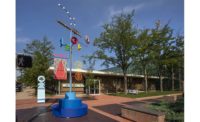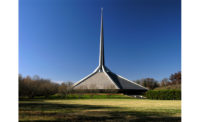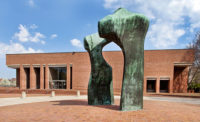In 1937, when Eliel Saarinen received an invitation to conceive a new house of worship in downtown Columbus, Indiana, he demurred. The Finnish-born architect and educator suspected that American churches demanded more flamboyance than Modernism could provide, and this small Midwestern community had no previous claim to innovative design. But the congregation soon brought the architect around by assuring him that Modernism’s restraint reflected its ethics as well as the local culture. Even before Saarinen completed First Christian Church in 1942, the once-improbable building was hailed as the most daring of its kind.
Columbus defied expectations repeatedly thereafter. Today it is home to one of the first glass-pavilion banking halls, designed by Eliel’s son, Eero, as well as career-defining commissions by the likes of Kevin Roche and Michael Van Valkenburgh. Of the dozens of cutting-edge designs completed in the city over the last 75 years, seven are National Historic Landmarks.
While Columbus’s treasures are periodically thrust into the limelight—most recently by the indie film of the same name—more contemporary progressive building has slowed to a trickle. But now, a $1.5 million initiative called Exhibit Columbus aims to reinvigorate the city’s stature as a cultural destination by stimulating fresh work. “Columbus is a community that decided it was open to new ideas, but it had become known for what it did—not what it was doing,” says Richard McCoy, who is spearheading Exhibit Columbus. To kick off the program, organizers invited 17 up-and-coming architectural teams—whose members range from gallery-represented designers to Midwestern architecture students—to create a series of installations across the city.
On the eve of the exhibition’s launch in late August, Columbus mayor James Lienhoop told a 700-person audience gathered in the Van Valkenburgh–designed Mill Race Park that Exhibit Columbus will test “whether our community is ready to remember the legacy [it has] inherited and whether they are prepared to steward it.”
Named for J. Irwin and Xenia S. Miller, who were the guiding forces behind Columbus’s distinguished 20th-century architectural heritage, the Miller Prize installations clearly embody this drive forward. Encouraging a dialogue between past and present, the program matches five emerging designers with five of the most significant Modernist sites on downtown Fifth Street.
On one corner of the First Christian Church site, for example, Milwaukee-based studio:indigenous has created an homage to the wiikiaami shelters of Indiana’s indigenous Myaamia people, using rebar and metal mesh. As it rises, this diaphanous conical form swerves toward the church’s famous 166-foottall campanile.
In the plaza of the I.M. Pei–designed Cleo Rogers Memorial Library that faces First Christian, Boston-based IKD encircled Henry Moore’s Large Arch sculpture with tiered viewing platforms made of cross-laminated timber. During opening weekend, a constant throng of visitors explored, scampered over, and relaxed on the observation decks.
The theme of catalyzing interaction extended to Mill Race Park, where New York– and Tucson-based Aranda\Lasch arrayed 2,800 pieces of salvaged Indiana limestone in circles and stacks over 3.5 acres of open lawn, to encourage more specific uses like theatrical performance or game play. And at the Rochedesigned Cummins Corporate Office nearby, New Haven’s Plan B Architecture & Urbanism inserted small, man-made hills into the landscape, as well as freestanding, reflective steel columns within the building’s soaring pergola, visually activating the space and offering spots for taking a break—or a selfie.
Meanwhile, the fifth project, by Los Angeles architects Oyler Wu Collaborative, dovetails steel panels and tubes around former drive-through teller lanes of the Eero Saarinen–designed bank (now a conference center). The complex shapes form enclosures and street furniture that engage the casual passerby. “We really thought of this as something for the people who had walked through that plaza a thousand times but had never thought to stop or appreciate the architecture,” explains Dwayne Oyler.
Indeed, Exhibit Columbus seeks to burnish the city’s reputation precisely for the people who call it home. “We wanted residents to be tourists in their own town, because the excellence here is taken more for granted than it should be,” McCoy said on the event’s first Sunday morning—normally a time of the weekend devoid of activity—as people strolled along Washington Street.
McCoy believes that Exhibit Columbus could help bring about other long-term goals, such as preservation or commissions for permanent buildings. He also hopes to banish any contemporary architect’s doubt that Columbus remains a vanguard town for new design ideas: “We just created a bunch of national ambassadors for this city, who care about it and who are invested in it.” Exhibit Columbus installations will remain on view through November 26, and the initiative will commence a second cycle next year.



















Post a comment to this article
Report Abusive Comment